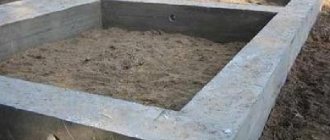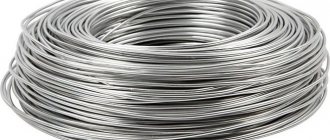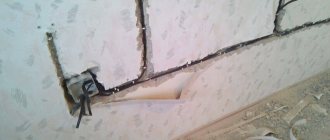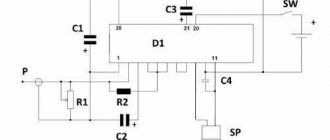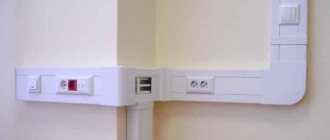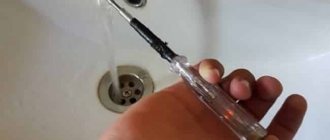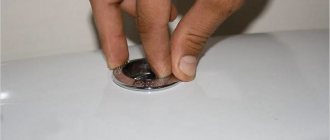Any master knows that when replacing wiring in an apartment, you have to make holes in the walls. The resulting construction dust settles throughout the room. Is it possible to make the work process and subsequent cleaning easier?
A few tips on how to carry out gating without dust will be useful to those who are undertaking repairs.
Requirements and standards
Figure 1. Grooving a concrete wall
Before you can chisel a concrete wall for dust-free wiring yourself, you need to carefully prepare for the work. First, you should calculate the wiring plan by drawing the future location:
- sockets;
- switches;
- lighting points.
The standards for wiring are specified in SNiP 3.05.06-85. Among the points that you need to pay special attention to are:
- The groove should be carried out horizontally/vertically, no curved lines. The only case when it is allowed to deviate from this rule is when gating in walls with a slope. Then the furrow can be positioned parallel to the slope.
- Between 2 points you can rotate the furrow once. This is due to the fact that a turn is an inflection point, and excessive twisting will lead to dire consequences.
- The groove width is 30 mm, depth is 26 mm.
- It is impossible to touch the internal structure, as this will lead to damage to the frame.
- Brick is easier to chip than concrete. This must be taken into account when choosing technology.
- A protective mask is required during work.
Failure to comply with these rules and regulations threatens the owner not only with sanctions from the relevant authorities, but can also lead to the destruction of the walls. Therefore, you should not put your life and the lives of loved ones on the line, risking what is most precious, but carefully follow the instructions and rules.
A hammer drill with an attachment is a tool for punching walls
Most often, chipping concrete walls is performed with a hammer drill, since it is considered a fairly powerful power tool. A rotary hammer can easily replace a drill, a screwdriver, and even a jackhammer. Its use allows you to speed up gating and make the process less messy. For this purpose, a hammer drill with an 18-24 drill bit (depending on the required groove width) is suitable for working on concrete. The hammer drill is set to the “impact with drilling” mode and holes are made along the entire length of the intended groove. You should try to drill them as close to each other as possible. Then the drill is replaced with a spatula, with which they begin to select a groove. It is important to place the spatula along the groove so that its edges are even.
When walls are being tapped for wiring
Grooves (or grooves) are important elements of hidden wiring. They are recesses of the required width knocked out in the wall. Cables are laid in the channels, through which electric current is supplied to sockets, lighting devices and switches. Hidden wiring, unlike external wiring, is compatible with any interior. It helps hide unsightly communication lines.
Gouging requires special preparation of the room and takes a lot of effort and time.
Before starting work, it is worth studying the requirements of the PTE and PUE, failure to comply with which can lead to emergency situations.
In what cases are walls tapped for wiring?
Creating a groove is an invariable attribute of hidden wiring. A groove is understood as a recess made in concrete, brick, plaster or other material for laying wires. With the help of the latter, household voltage is supplied to sockets, switches and lamps.
An alternative option is to create external wiring, when the wires are on the surface of the wall or placed in special boxes.
Hidden wiring is more in demand, because with its help you can hide communications in the walls and thereby improve the appearance of the interior.
The problem is that creating a groove requires preparation, considerable physical effort and time. In addition, it is important to know the requirements of the PUE and PTE, without which installation of wiring can lead to many problems.
It is also important to study the resolution 508-PP “On the organization of reconstruction and (or) redevelopment of residential and non-residential premises in apartment buildings and residential buildings.”
Standards and restrictions when tapping walls for wiring
Before you take the tool to the wall, you need to properly prepare for the process. Initially, you need to calculate the wiring plan on a piece of paper. Mark the locations of future sockets, switches and lighting points throughout the house. There shouldn't be too many of them. Each element must be defended by a vital necessity. You also need to take into account the materials of the walls and decide on the best method of gating this material.
Regulatory documents on the distribution of wires are collected in SNiP 3.05.06-85. It is best to study them in detail once, so as not to have to redo everything again later. Here are the main points to focus on when performing work:
- The groove (deepening) must be carried out strictly horizontally or vertically. There should be no oblique lines. The only exception is when the wiring needs to be installed on walls with a slope, for example, in the attic. Then the line can run parallel to the slope of the wall.
- Between two electrical points, the groove can only be turned once. Each turn is a bend in the cable, which will heat up more in these places. Such conditions can lead to dangerous situations.
- The grooves have size restrictions. The maximum permissible groove width is 30 mm, and the depth is 26 mm. The total length of the route from the distribution box to a specific point should not exceed 3 meters.
- It is imperative to maintain indentations: from the battery and gas pipes - at least 40 cm, from the door - 10 cm, and from the ceiling and floor at least 5 cm, although it is advisable to still adhere to 10 cm.
- It is prohibited to do grooves on internal load-bearing walls. The thickness of the external walls will not be affected by a shallow ditch, but for load-bearing partitions you need to obtain permission from the municipal authority. This is especially true for panel houses. Grooving walls for wiring on the first floors must be done with special care - the lower walls support not only the roof, but the entire building.
- It is forbidden to touch a reinforced concrete structure when cutting. This may lead to a violation of the integrity of the structure and, as a result, loss of its reliability. In case of urgent need, the grooves in reinforced concrete should be shallow and the reinforcing mesh should not be affected.
- When making grooves in the ceiling, it is necessary to calculate the shortest path to the lighting point.
- It is prohibited to make grooves in the floor slab. If you need to conduct wiring along the floor, then the best solution would be to do it in a concrete screed. It needs to be filled with the grooves for the wires in mind.
- Brick walls are easier to chip than concrete walls. This must be taken into account when choosing a tool and having the appropriate skills.
- When gating, it is necessary to protect the respiratory tract from dust with a mask or respirator.
Important! Grooving always occurs with increased noise effects. The whole house will hear your work, thanks to the inevitable vibration of the walls. Therefore, such work should be carried out on weekdays from 10 to 17 hours. Then mutual understanding between the residents will save your nerves during neighbor renovations.
Methods
Figure 2. Grilling with a hammer drill
There are 4 methods of gating:
- Hammer and chisel - popular because they are cheap. Among the disadvantages, it is worth noting the duration of the work and the curvature of the highways.
- Impact drill - when using a hammer drill, the grooves come out with uneven edges, but the procedure is completed quickly.
- Grinder – there is a lot of dust when working. However, the grooves are smooth.
- Wall chaser – the main disadvantage is its high cost. However, it is fully justified by its efficiency: the recesses are smooth and dust-free.
Wall chaser
A specialized wall chaser is exactly the tool that is best used to groove concrete walls for wiring. It successfully overcomes the resistance of high-strength reinforced concrete. The operating principle of the electric machine is based on two diamond-coated discs making neat, even, parallel cuts in one step to a given depth. Subsequently, the material is removed using a hammer drill. The design of many wall chaser models allows you to adjust the distance between the cutting wheels and obtain grooves of a certain width and depth. A wall chaser is often used at home, since it can take quite a long time to drill holes into a concrete wall for wiring with this tool. Thanks to the ability to connect a construction vacuum cleaner to the furrow cutter, the dust concentration in the room air does not exceed permissible standards. The disadvantage of this tool is considered to be too high a cost, which makes it unprofitable to purchase it for one-time use.
Preparation and marking of the working surface
First of all, you need to check the walls for old wiring. For this, there are special testers and indicators, the principle of which is based on the general electrical circuit. It looks like this - from the general switch to the electrical point, for example, the socket has two wires - phase and neutral. According to the phase current, current flows from the switch to the point constantly, regardless of whether something is connected there or not. The neutral wire is energized only when the device is turned on. And only then does the current return back to the switch. The indicators catch the phase wire. Many indicators have a special light on top that lights up when a target is found. This preparation stage is necessary to protect yourself from electric shocks.
After checking, you need to draw the future route on the wall - from the junction box to each connection point.
Before starting work, be sure to curtain the doorways with a damp cloth or construction film. Don’t rely on a tightly closed door - small particles of dust will still find a loophole.
Preparing walls for gating for wiring
Before cutting the boundaries of the groove, they need to be marked with a construction pencil. If this is not a new building, then before marking you need to use a probe or tester to make sure that there is no old electrical wiring in this place. To avoid accidentally damaging it.
What else should you pay attention to? All grooves and electrical wiring are laid either strictly vertically or horizontally. Why is this being done? When we place switches, sockets or some other element on the wall, we must always know for sure that electrical cables go from this place, either strictly vertically upward or vertically downwards. Under the ceiling, the wire runs only horizontally, at a height of 10-15 cm from it. Often sockets are placed close to the floor. Consequently, after many years you will understand that you definitely cannot drill into the wall above it, nor hang shelves, nor attach pictures, etc. And so on throughout the house. This rule is mandatory for everyone, everywhere.
Before cutting the boundaries of the groove, they need to be marked with a construction pencil.
Grinding with a grinder for wiring
The two-handed device is great for cutting through dense concrete and creating numerous long channels for wiring.
For normal operation, in this case, a diamond disc is used, since its strength allows it to successfully complete the planned amount of work.
Creating narrow lines will not require the use of other devices, since the thickness of the cutting disc will be sufficient. Otherwise, the side lines are cut with an angle grinder, and the central part is cleaned with a chipping unit.
Grooving is performed at low power: 500 W is enough when using high-quality cutting attachments.
It is important to follow safety precautions when working with a miter saw and hold it firmly by both handles. The device must not be allowed to fall, since despite the possibility of instantaneous shutdown, the rotation of the disk will not stop immediately. There is a high probability of damage to the legs, floor, walls, and people standing nearby.
To prevent the cutter from flying off after the first cuts, you need to tighten the fastening nut tightly.
Dust-free chipping
During repairs or when replacing wiring, you will have to lay grooves or make holes in the walls.
This creates a large amount of construction dust that settles throughout the room.
To groove a wall for wiring without dust, you can use the advice of experts:
- It is good to moisten the surface on which the wiring channel will be made.
- Use a household vacuum cleaner to catch dust.
- It is best to take a wall chaser with a special vacuum cleaner connected to it. Then making holes in the walls will take place in a comfortable environment.
There is also a method for cutting channels with a grinder without dust, such as wet cutting of concrete. This method is carried out using a hose that continuously supplies water to the cutting disc and the cutting area. You need to be very careful, otherwise liquid may get on the power tool, which will render it unusable.
After finishing the gating, the channels should be treated with a primer and the cable should be secured in them. Seal the grooves with plaster, mortar or putty.
Sources:
https://c-triada.ru/podelki/kak-sdelat-shtrobu-v-betone-bolgarkoj.html
DIY wall chaser
Homemade plywood casing for an angle grinder for wall slitting
To make walls for wiring with your own hands, you can make a homemade wall chaser. To make it you will need:
- Powerful angle grinder from 1.2 kW. This indicator is extremely necessary, since the tool will rotate two diamond disks.
- Pipe with an internal cross-section of 50 mm (metal).
- Sheet iron with a thickness of 2 mm or more.
- Wheels or bearings in the amount of 3-4 pieces with a diameter of 2-3 cm.
- Metal spacers for their installation between two disks (it is better to order them in advance from a turner).
- Metal fasteners (nuts, screws).
- Two or three sections of small cross-section pipes.
Additionally, you need to prepare a file, a vice, a welding machine, a hammer, a caliper, a ruler, and a pencil. The finishing touch is coating the discs with nitro enamel. Therefore, you need to prepare it too.
The principle of forming a homemade wall chaser is to attach two discs to an angle grinder for cutting on concrete. Between them, with the help of gaskets, the required distance is maintained (according to the width of the future groove).
If the grinder does not have threads for fixing two discs, it is not worth the risk. During work, one of the working elements may fly off and injure the technician.
Wall chaser from a drill
Making the right tool from a drill with your own hands is as easy as shelling pears. You just need to fix the desired cutter in the drill chuck. But the formation of grooves using such a device is not entirely of high quality. The grooves have different depths and widths.
Useful tips
To quickly groove a wall near the ceiling, use stable stands. It can be a stepladder, but it is difficult to put strong emphasis on it.
Open the windows to allow fresh air into the room, regardless of the amount of dust generated. Safety glasses and a respirator mask will also help protect yourself.
After you have grooved the wall for the wiring, and have not yet completed the finishing work, mark with a pencil the distances from the corners of the walls and ceiling to the grooves. Take a photo that will show you where to lay the cables in the future. This is useful, for example, if you need to drive a nail into the wall, which should not get into the laid wires.
How to make aerated concrete or foam blocks
Aerated concrete is a type of cellular material, an artificial stone used during construction work. In its production, quartz sand, cement, special gas generators and additional mixtures are used.
The material has good qualities and is convenient in construction. It has a soft structure, so there are no difficulties with gating.
To tap walls in aerated concrete or foam blocks, you can use the following tool:
- A wall chaser that allows you to create an even groove and reduce the loss of time for completing the work.
- Hammer.
- Angle pin machine.
- Drill.
Can be used:
- Pobedite crown 68 mm.
- Screwdriver.
- 8 mm straight groove cutter for wood. Because soft aerated concrete will be an excellent solution. Or you can use a drill of the same diameter.
- Profile for drywall - so that the groove is even.
Alternatively, you can use a chisel with a hammer or a homemade chisel device. In the latter case, a pipe 30-40 cm long with a pointed edge on one side is used (we mentioned this above).
How to groove a concrete wall for wiring without dust step by step
Figure 3. Dust-free chipping
Before starting work, you should clarify some points:
- presence of hidden wiring;
- its route;
- wall material.
Having chosen the appropriate method, you should apply markings to the surface of the walls, moving to the points where the sources will be located. Using a hammer drill, indentations are made along the line of future wiring. Using a spatula, drill a continuous furrow.
After gating, clean the furrow from dust, prime it and carefully place the cable inside. Seal the groove.
Do-it-yourself wall chipping.
To do wall slitting with your own hands, you need to know the clear sequence of all actions. Let's figure this out together:
- First of all, make a detailed layout of the electrical wiring and components;
- Then, if possible, clear the room of furniture and household appliances, since dust will be generated during work;
- We transfer the pre-drawn electrical wiring plan to the wall surface using a marker and a building level;
- Using an indicator, we check the marked surface for the presence of old electrical wiring. If it is detected, it is necessary to dismantle it or step aside at a distance of at least 15 cm;
- We perform gating of the marked area using one of the above options;
- After the channel is completely completed, it must be cleaned of dust and impregnated with a primer;
- The final step is to install the electrical wiring.
Grooving for sockets and switches is carried out using a hammer drill with special nozzles of the desired shape.
How to shingle brick walls
Brick is an artificial stone used for the construction of various objects. It is made from quartz sand, burnt raw material, unfired clay or limestone screenings. It differs in appearance, shape and characteristics.
Regardless of the material used, brick walls are difficult to chisel, so it is recommended to use professional tools to complete the job.
Optimal options:
- Bulgarian.
- Wall chaser.
- Chisel and hammer (for short sections).
When chipping, you need to be careful, because brick tends to crumble, so you can’t do it without safety glasses.
A small life hack is to use a ceramic drill and a screwdriver. The idea is to use the ceramic drill as a milling cutter, i.e. use the side edges for chipping bricks.
The channel is milled very quickly and without dust. This life hack is especially suitable for sand-lime brick.
How to ditch a monolith
Monolith is a popular building material used in the construction of various objects. Its peculiarity is the use of metal reinforcement and concrete, which is poured directly at the construction stage of the facility.
This technology has gained popularity due to its low price and high strength of finished reinforced concrete structures.
There are many questions regarding permission to groove in monolithic walls.
Here you can consider the following points:
- GOST R. 50571.15-97 allows installation of wiring if the work does not affect the functional features of the facility;
- SP 31-110-2003 - installation of hidden, but not pulled, wiring is allowed.
It is prohibited to install wiring in concrete columns, external walls and elevator shafts.
Tool used:
- Angle grinder.
- Wall chaser.
- Rotary hammer (for short sections).
Granite monoliths are especially difficult to handle, so in this case it is better to turn to professionals.
Hammer and chisel combination
A hammer and a chisel are a classic set of tools for punching a surface, if we are not talking about concrete or sand-lime brick. You can try to break through a less durable red brick with this union.
This option is labor-intensive and time-consuming. A convenient approach to the development of plastered surfaces that does not require large expenses.
First you need to mark the future channel. Next, the chisel is placed across the drawn line, and the top of the handle is hit with a sledgehammer, first knocking out no more than 1 cm deep. In this case, the angle of inclination is maintained so strongly that the tool stands almost parallel to the wall. Greater deepening is performed in the next approach, as well as expansion, if required.
The chisel is not placed along the direction of movement, since a lot of excess will almost certainly be cut off, and the empty areas will have to be putty.
The nuances of chipping a concrete wall
It is very difficult to work with a conventional wall chaser with two discs in such conditions. On concrete walls, soft metal plasticines quickly heat up. A regular grinder with one disc can cut concrete, and the grooves themselves are knocked out with a hammer drill or jackhammer. You can watch how to drill walls for wiring with a hammer drill from numerous videos on the Internet.
Don't forget to use safety glasses, because... During operation, sparks and abrasive particles fly with great speed and force.
Don't forget to use safety glasses, because... During operation, sparks and abrasive particles fly with great speed and force.
The process of slitting with various tools
To groove walls for wiring you will need:
- Construction pencil;
- Roulette;
- Hydraulic level;
- Wall chaser with a metal disc and a connected vacuum cleaner;
- Jackhammer.
Wall gating begins only after the electrical wiring plan has been approved. The first stage is marking the locations of sockets with switches according to the apartment plan. Wiring is also carried out separately for household appliances: TV, intercom, ventilation, alarm, etc. The height of the outlet from the floor is noted, then the distance from the slope of the door or window, or the corner of the room. Future points of sockets with switches and vertical places where the wall will be cut are marked strictly according to level. All electrical wiring runs along the ceilings:
- In monolithic-filled houses: under a false ceiling,
- In panel houses - in technical pipes that are already built into the wall.
You need to be very responsible when it comes to wiring in the kitchen, due to the large number of household appliances connected to the electrical network. Sockets must match the height and placement of kitchen furniture and connected appliances.
The first stage is marking the locations of sockets with switches according to the apartment plan.
They ditch the wall either with a wall chaser or a circular saw with a grinder with a metal disc and a connected construction vacuum cleaner to a depth equal to the diameter of the pipe + 10 mm and a width of approximately 30-40 mm for a socket or switch. If one channel carries several wires, for example, electricity to a TV, telephone, intercom, then it can be made wider. You can also put not one, but 2-3 tubes in it.
During work, we must not forget about safety precautions. When the groove is completed, places for socket boxes with switches are marked. If the hole is a little larger than the box, that's okay. After the wires are brought out into the box, it is walled up in the wall.
After tracks have been cut on both sides of the channel, the gap between them is processed with a jackhammer or hammer drill. Excess concrete is cleaned from the canal. You should not hollow out the wall too much.
When all the channels are cut, you can lay wiring in them.
During work, we must not forget about safety precautions.
Finishing movements
After the main groove has been laid, the recess is thoroughly cleaned of debris using a brush or a clean paint brush. If necessary, the edges of the cut lines are sanded until smooth.
Now you need to seal the recess to the same level as the main surface.
The recess is primed in two layers, leaving each to dry completely for 10-12 hours. You can, of course, skip this stage, but then cracks will almost certainly gradually appear - without adhesion, the putty will fall off.
The primer will provide the necessary level of adhesion, and putty is used as a filler. Use a spatula to scoop up a small amount of solution, apply the tool forcefully to the wall and move it to the side.
Closing the wiring
You can complete the sealing in several steps, gradually increasing the void, but then you need to think about what and how to compact the putty.
When the solution is completely dry, the wall is sanded with abrasive paper manually or using a sanding machine.
Then it is enough to cover everything together with the rest of the surface with a primer to begin the cosmetic finishing of the room.
How to make a cable channel in the wall with a chisel and hammer
To create a small groove in the wall you will need a hammer and chisel. It is relatively easy to work with a brick surface, but making a furrow in a concrete slab in this way is difficult.
Work order:
- Marking the edges of the furrow. This is done using a chisel, and it is placed along the marked line.
- Creating a groove. The chisel is turned across the furrow and concrete or brick is gradually removed from it.
- Deepening the groove. If it was not possible to achieve the required depth at once, then make a second pass.
After creating the grooves, they are cleaned of dust and then primed. All that remains is to lay and secure the cable. At the last stage, the grooves are puttied and the finish is applied to the wall.
How to make a groove with a hammer drill. Bulgarian
There are three ways in which you can make a strobe :
Make a groove with a wall chaser
Well, this method is simple. Markings are drawn on the wall and calmly follow the markings. slowly, using a wall chaser, a groove is made. Next, using a hammer drill, the remaining concrete is knocked out.
In this article I would like to focus more on those. who will be making a wall and does not have a professional tool, such as a wall chaser. For those. who has a hammer drill and... maybe Bulgarian . Two ways. described below. more suitable for beginners.
Make a groove with a grinder
Making a groove with an angle grinder is not difficult. For this, a grinder with a power of at least 800 W is sufficient. 125 diameter and a diamond wheel for concrete. There are two types of concrete circles. with and without technological slots. Take it for working with technological slots. The grooves are not suitable without cutting slots. Also, don't save money. Buy a good quality diamond wheel. because you can burn the grinder.
When you cut concrete . stop the grinder every 30 cm for 3 seconds without removing it from the groove. so that it blows dust out of the engine at idle and cools down a little.
The width of the groove is made depending on the type and amount of cable laid in it. If you are installing one cable. then it makes sense to make the groove not the width of the cable. and on the thickness and lay it end-to-end in the groove . Such a groove does not need to be cleaned later with a hammer drill and is small in size. just cover it up.
A groove for one cable laid end to end.
Perforate the groove
This is one of the simplest and most cost-effective methods. You only need a hammer drill and an 8mm drill if you are doing it for one cable. A marking line is immediately drawn along which holes are drilled as close to each other as possible. Then, using the same drill in the “impact” mode, a groove is knocked out. I do not recommend using a spatula, etc. Various devices were tested and nothing turned out to be better than a regular drill for concrete. Only the drill should be as small in length as possible. Do not forget to lubricate the tip of the drill with grease.
1 meter of groove is knocked out in 7 minutes (3 minutes to drill and 3 minutes to clean).
Safety precautions
- When working with an angle grinder, follow these rules:
- When starting to chip, put on safety glasses, a respirator, and gloves. Work clothes should not interfere with movement.
- Be sure to check the functionality of the grinder. The deformed disk is replaced.
- Use the grinder correctly. This makes work safe. The handle is held with 2 hands.
- The power cable is pulled away from the rotating nozzle. If the disk hits the wire, it will cause a short circuit and stop the tool.
- Are not in the range of the nozzle. The tool is held so that the sparks fly to the side.
- Water is placed near the workplace. It is used to extinguish fires that may arise from a spark.
- Do not place the working tool on any surface. If it is necessary to move the angle grinder, turn it off. Any careless movement can lead to injury to the technician.
- The disk heats up during operation, so do not touch it immediately after turning off the device.

